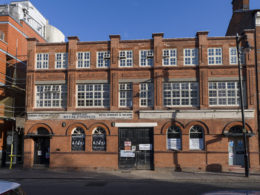By Helen Baws, research volunteer, and Sophie Slade
Many of the factories were small, covering the footprint of a few domestic houses. This was due to the nature of the work in the Jewellery Quarter, much of which was based on specialised skills done by hand. Only a few of the purpose built spaces were on a bigger scale. Regardless of size many of the purpose built manufactories were referred to as ‘works’, and their names reflected a more formalised approach to business, such as Variety Works, Unity Works, Standard Works, Gothic Works etc.
The Canada Works and the Standard Works
Around 1880 a group of buildings, designed as multi occupancy business premises, were constructed on the corner of Vittoria Street and Regent Place. The Standard Works contained offices, warehouses, and shopping (workshops). A section of the building was known as the Canada Works (due to the overseas connections of the Levetus Brothers, who were based here). Now leased by Ruskin Mill Land Trust, the whole building complex is used as a learning centre for people with special educational needs. It also houses the Hive Community Hub, with a café, art gallery and craft workshop space.
No. 9 Regent Place, was added as an extension to the Canada Works in the 1880s, and conserved with a JQTH grant in 2021. Distinct from the rest of the building for its slightly plainer facade, some of the visual impact of the brick, stone and stucco render has been lost due to being painted over. Grade II listed, its innovative construction, using rolled wrought iron beams in the basement, was intended to be fireproof. Perhaps this was effective as the building suffered at least two fires in 1889 and 1891 and the structure remained intact. The beams were originally painted with oil and lime wash to preserve them. A 1999 report by English Heritage described its technological significance:
“The combined use of rolled-iron and cast-iron beams in the same structural frame is of considerable interest, representing a transition in the development and application of structural ironwork.”
The building is also significant as it contains the only surviving section of rear shopping from the Canada Works.




